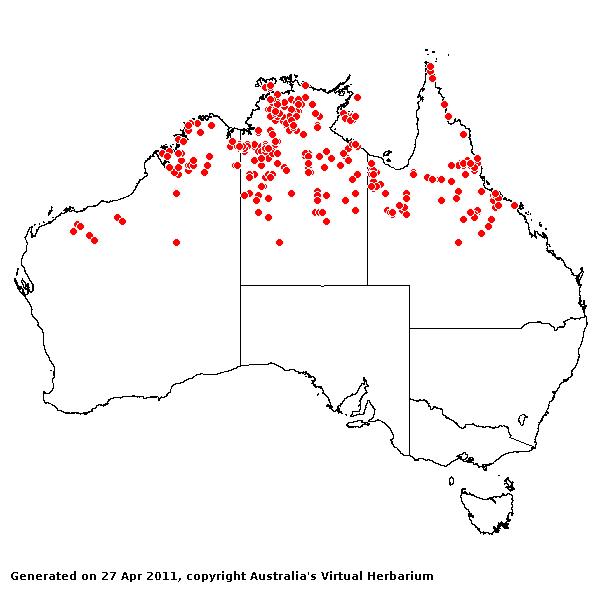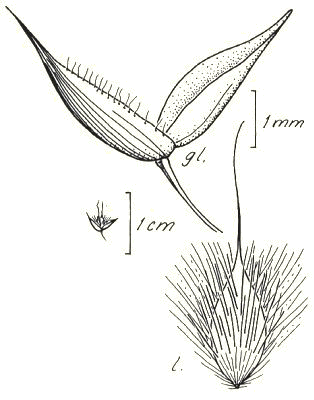Eriachne ciliata R.
Br. Prodr. 184(1810).
Classification. (GPWG 2001) : Subfamily
Micrairoideae. Eriachneae.
Type of Basionym or
Protologue Information: HT: R. Brown 6264 pro parte, 14 Feb 1803,
Australia: Northern Territory: Darwin and Gulf District: Melville Bay (Arhem
North Bay) (BM; IT: K).
Key references
(books and floras): [1810]. R.Brown, Prodromus (184), [1878]
G.Bentham, Flora Australiensis 7 (629), [1952] C.A.Gardner, Flora of
Western Australia 1 Gramineae (49), [1981] M.Lazarides in J.Jessop
(ed)., Flora of Central Australia (443), [2002] D.Sharp & B.K.Simon,
AusGrass, Grasses of Australia.
Illustrations:
[2005] K.Mallet (ed.), Flora of Australia 44B: Poaceae 3 (Fig.
26A-I).
Habit. Annual
or ephemeral. Culms erect, stature slender to delicate, 7–35 cm tall. Mid-culm
nodes pubescent. Lateral branches branched or fastigiate. Leaf-sheaths
antrorsely scabrous, hairy. Ligule a fringe of hairs. Leaf-blades 1–5 cm long,
1–4 mm wide. Leaf-blade surface scabrous, indumented.
Inflorescence.
Inflorescence compound, a panicle. Panicle lanceolate or ovate, 4–12 cm long,
1.5–4 cm wide.
Spikelets.
Spikelets pedicelled. Fertile spikelets 2-flowered, both fertile, comprising 2
fertile floret(s), without rachilla extension, ovate, laterally compressed, 3–4
mm long.
Glumes.
Glumes similar, thinner than fertile lemma. Lower glume ovate, membranous,
without keels, 7–9 -nerved. Lower glume surface glabrous or indumented. Lower
glume apex muticous or mucronate. Upper glume ovate, 2.5–5 mm long, membranous,
without keels, 7–9 -nerved. Upper glume surface smooth or scabrous or
tuberculate, glabrous or indumented. Upper glume apex muticous or mucronate.
Florets.
Fertile lemma 2–3.5 mm long, without keel, 5 -nerved. Lemma surface indumented.
Lemma apex awned, 1 -awned. Median (principal) awn 1.5–3 mm long overall. Palea
apex entire or dentate. Grain 1.3–1.5 mm long.
Continental
Distribution: Australasia.
Australian
Distribution: Western Australia, Northern Territory, Queensland.
Western Australia:
Gardner, Fitzgerald, Dampier. Canning, Fortescue. Northern Territory:
Darwin & Gulf, Victoria River, Barkly Tableland, Central Australia North. Queensland:
Burke, Cook, Mitchell, North Kennedy, South Kennedy.
Notes.
Diagnostic characters include the slender short-lived habit, prickly-hispid
usually antrorsely curved indumentum, short rigid often flat blades, many-noded
culms and short internodes, open panicle with filiform divisions and prominent
pulvini, small spikelets, florets slightly shorter than glumes, long-ciliate
awned lemmas, entirely pubescent (on body) palea, and flattened dark caryopsis.
The species resembles E. capillaris and E. agrostidea, but the
former species differs by its awnless lemmas, and the latter by its longer awn
on the lemma. The features distinguishing E. ciliata from the closely
allied E. semiciliata are discussed under the latter species.
Endemic.
Predominantly N of 20ºS in Qld, N.T. and W.A. A common species of shallow and
skeletal, sandy or loam soils on laterite, sandstone, quartzite or granite.
Common habitats include plateaux, hillslopes, ridges, gorge floors, and
sometimes seasonally wet sites in and near watercourses. Sites are often
gravelly, rocky or stony. Flowers and fruits chiefly Feb.-May (late-summer and
autumn); sometimes secondary or persistent inflorescences June-Oct. (winter to
mid-spring).










